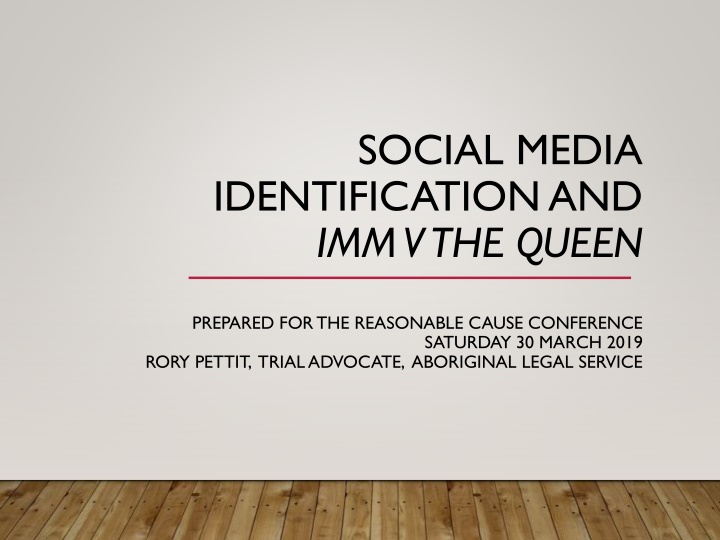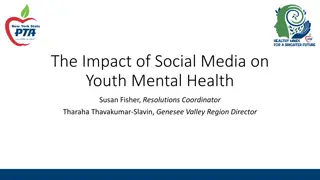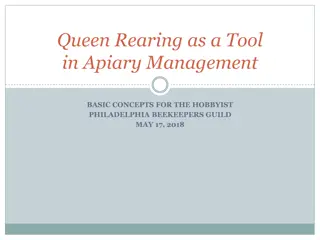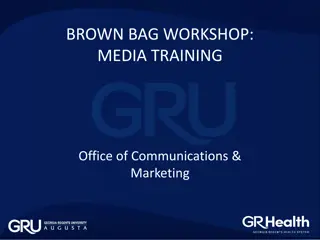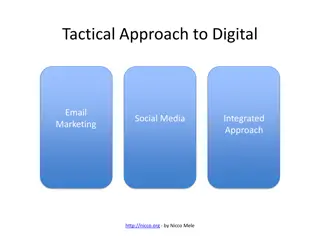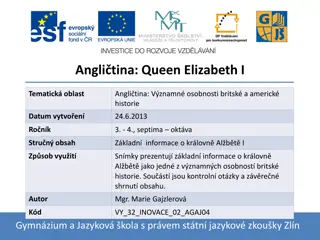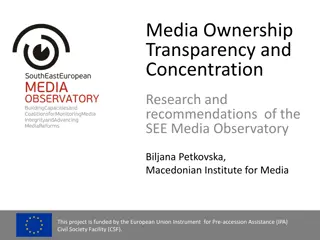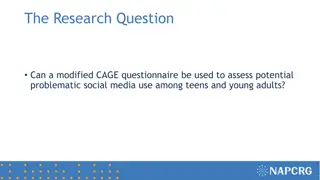Social Media Identification and IMM v The Queen
This presentation delves into the challenges of identification evidence, with a focus on social media, and explores the probative value and reliability of such evidence in legal contexts. It includes a hypothetical scenario, general dangers of identification evidence, and insights into the risks associated with misidentifications, as discussed by legal authorities.
Download Presentation

Please find below an Image/Link to download the presentation.
The content on the website is provided AS IS for your information and personal use only. It may not be sold, licensed, or shared on other websites without obtaining consent from the author.If you encounter any issues during the download, it is possible that the publisher has removed the file from their server.
You are allowed to download the files provided on this website for personal or commercial use, subject to the condition that they are used lawfully. All files are the property of their respective owners.
The content on the website is provided AS IS for your information and personal use only. It may not be sold, licensed, or shared on other websites without obtaining consent from the author.
E N D
Presentation Transcript
SOCIAL MEDIA IDENTIFICATION AND IMM V THE QUEEN PREPARED FOR THE REASONABLE CAUSE CONFERENCE SATURDAY 30 MARCH 2019 RORY PETTIT, TRIAL ADVOCATE, ABORIGINAL LEGAL SERVICE
TWO PARTS I. General problems of identification evidence More acute with identifications from social media II. IMM, probative value, and (un) reliability Social media identification a useful analysis tool
TOPICS 1. General problems of identification evidence A) Facebook identification: factual hypothetical B) Dangers of identification evidence C) Facebook cases II. IMM, probative value, and (un) reliability D) s 137 and probative value after IMM E) Three categories of reliability
PART 1: ID EVIDENCE A) FACEBOOK HYPOTHETICAL A woman, Jane, is sitting in the kitchen of her home. Without warning, a man bursts in the front door, holding a knife. He is unknown to her. He grabs Jane s handbag, which is sitting on the kitchen table, and flees. The interaction is over in seconds, but Jane was able to see the man s face and make some general observations about him. Jane didn t have her glasses on at the time, and she is very slightly short-sighted. Jane s friend Sue was in the other room, with a window out onto the street. Afterwards, Jane describes the man to Sue. Sue says I saw that same man run past the window, and though I couldn t really see his face it looked like a man called Andrew Jones I sort of know his mother, they live in the next suburb. Sue opens Facebook on her phone, and finds a photo of Andrew Jones. She shows the photo to Jane and says it was him, wasn t it? Sue looks at it and says yes that s him, I m sure of it. They tell police and provide the above version of events, and Andrew Jones is later charged with Robbery.
B) GENERAL DANGERS OF IDENTIFICATION EVIDENCE Dangers: danger of misidentification Numerous wrongful convictions Warnings in Evidence Acts s116 and s165 Mason J in Alexander v R (1981) 145 CLR 395: Identification is notoriously uncertain. It depends upon so many variables. They include the difficulty one has in recognizing on a subsequent occasion a person observed, perhaps fleetingly, on a former occasion; the extent of the opportunity for observation in a variety of circumstances; the vagaries of human perception and recollection; and the tendency of the mind to respond to suggestions, notably the tendency to substitute a photographic image once seen for a hazy recollection of the person initially observed.
DISPLACEMENT Risk of Mason J s psychological phenomenon of displacement Also described by Murphy J in Alexander v R (1981) 145 CLR 395: Lastly, there is the "displacement" effect. Having been shown a photograph, the memory of it may be more clearly retained than the memory of the original sighting of the offender and may, accordingly, displace that original memory. The general dangers in identification of a stranger are compounded when the first identification after the crime is from a photograph. The well-known displacement effect tends to reduce the reliability of a later identification.
DISPLACEMENT AND SOCIAL MEDIA Historically: witnesses shown physical photo of accused, then later undertake a photo board ID from which they pick the accused Little difference between historical examples and hypothetical Suggestibility + no foils as in photo board Concern: will happen much more often than historical examples Evidence tainted before Police involvement
RECOGNITION AND DISPLACEMENT Displacement possible when identifier recognises offender? Will depend on degree of recognition Carr v R (2000) 117 A Crim R 272: Tasmanian CCA recognition cases will often involve just as much danger of mistaken identification as cases involving persons first seen at the times of their alleged crimes [ ] [danger will depend on the degree of familiarity of the witness with the accused. Hypothetical: Sue makes identification, not Mary displacement still possible knows of has suggested to herself
SINGLE SUSPECT IDENTIFICATION Single suspect ID from one photo or one person Enhances risk of displacement, especially when accompanied by factors that suggest guilt Examples (all real cases): a. Single suspect at Police Station b. Sitting in back of Police car c. Presentation of single photo by Police d. ID from Facebook linked to serious crimes e. Dock identifications without prior identification by a witness
DIFFICULTIES TESTING ID IN COURT Danger of ID evidence: mistaken witnesses convinced they are right R v Marshall [2000] NSWCCA 210: The prejudice often associated with identification evidence is that, although mistaken, it is frequently given with great force and assurance by the person who made the identification. These are matters about which witnesses frequently refuse to admit the possibility that they might have erred and, accordingly, give evidence in a particularly definitive form. Cross-examination is a limited tool: witness honestly mistaken In part why identification evidence considered inherently unreliable (s116, 165 UEA)
FACEBOOK CASES Strauss v Police [2013] SASC 3 Peek J ID from Facebook by complainant of assault after suggestion by two others present accused was present Comprehensive decision: ID excluded for insufficiency of evidence So called Facebook identifications have none of the safeguards which accompany a properly executed formal identification procedure conducted by the police. Purported Facebook identifications from group photographs are particularly dangerous in that they present a seductive and deceptive air of being a plausible identification but in fact rarely involve a group of people each having similar features to the accused; they suffer from foil bias as discussed above. [ ] The displacement effect will then later proceed to erase from the memory the subtle differences between the real offender and the person identified.
FACEBOOK CASES CONTD R v Crawford [2015] SASCFC 112 ID from Facebook after home invasion (offender had sunglasses on), police told victim name of suspect who looked accused up Appeal against admission of evidence at trial Majority: (despite finding probative value low): dismissed appeal, directions sufficient to cure Peek J: strong dissent, would have excluded under general unfairness, Christie or public policy
FACEBOOK CASES CONTD Bayley v The Queen [2016] VSCA 160 ID from Facebook of Adrian Bayley, photo seen in circumstances linking him to Jill Meagher murder later photo board ID, convicted of rape 12 years prior to Facebook ID CoA unanimously allowed appeal (post-IMM) Found that Facebook ID of very low probative value, and: was in some respects no better than a dock identification. Indeed, it could reasonably be viewed as worse.
PART II: IMM, PV, (UN)RELIABILITY DEFINITIONS s 137, Evidence Act: In a criminal proceeding, the court must refuse to admit evidence adduced by a prosecutor if its probative value is outweighed by the danger of unfair prejudice. Probative value dictionary the extent to which the evidence could rationally affect the assessment of the probability of the existence of a fact in issue Degree of relevance? Or content (relevance) + genesis?
CREDIBILITY AND RELIABILITY Common law definition: Nettle and Gordon JJ, IMM: Before proceeding further, it is important to be clear abut what is meant by credibility and reliability in this context. At common law, a distinction was ordinarily drawn between the two concepts. The credibility of a witness was commonly understood as meaning the truthfulness of the witness whether the witness genuinely believed that he or she was telling the truth. Reliability on the other hand, referred to the ability of the witness accurately to discern and relay the truth as to an event, including the witness s ability to observe and remember facts.
CREDIBILITY AND RELIABILITY Evidence Act Dictionary Credibility: credibility of any part or all of the evidence of the witness, and includes the witness ability to observe or remember facts and events has given, is giving, or is to give evidence. So: subsumes both credibility and reliability from common law honesty and capacity to observe Reliability not defined, but goes beyond common law reliability given that is subsumed by credibility definition in the Evidence Act
IMM V THE QUEEN [2016] HCA 14 Appeal from admission of tendency evidence Issue turned on dispute between Victorian/NSW Supreme Courts when determining PV: do we assess credibility/reliability or not? Majority: NO proceed on an assumption that the jury will accept evidence, precludes this assessment Gageler J: YES, both Nettle/Gordon JJ: YES, both
PROBLEM WITH IDENTIFICATION EVIDENCE POST-IMM Any identification generally a positive, black-and-white assertion, i.e. I saw X commit an offence . If credibility/reliability cannot be assessed then: Facebook ID hypothetical AND ID after properly conducted photoboard . Same probative value: highest possible in a pure identification case, couldn t be more relevant Why degree of relevance not complete picture
TWO TAKEAWAYS FROM IMM How to deal with this problem? Two takeaways from IMM that might help 1. Justice Heydon s hypothetical dark and foggy night 2. Types of reliability
JUSTICE HEYDONS HYPOTHETICAL At [50] of IMM: It must also be understood that the basis upon which a trial judge proceeds, that the jury will accept the evidence taken at its highest, does not distort a finding as to the real probative value of the evidence.The circumstances surrounding the evidence may indicate that its highest level is not very high at all. The example given by J D Heydon QC was of an identification made very briefly in foggy conditions and in bad light by a witness who did not know the person identified. As he points out, on one approach it is possible to say that taken at its highest it is as high as any other identification, and then look for particular weaknesses in the evidence (which would include reliability).On another approach, it is an identification, but a weak one because it is simply unconvincing. The former is the approach undertaken by the Victorian Court of Appeal; the latter by the New South Wales Court of Criminal Appeal.The point presently to be made is that it is the latter approach which the statute requires. This is the assessment undertaken by the trial judge of the probative value of the evidence.
HEYDON JS HYPOTHETICAL CONTD 1stquestion: is simply unconvincing a static bar or spectrum? Do circumstances bring ID to a point where it drops off to become simply unconvincing OR: is it a scale of unconvincingness ? Second makes more sense Problem: appears to simply be another name for unreliability Nevertheless: VCA in Bayley used IMM to find that Facebook ID in that case was simply unconvincing , lowering its probative value Relied on delay and displacement rather than foggy night
TYPES OF RELIABILITY Suggested way of understanding these problems: three types of reliability 1. Personal reliability Per common law: capacity to observe and relay events: Sight, hearing, drunkenness, memory etc
TYPES OF RELIABILITY CONTD 2. Circumstance reliability (Heydon s hypothetical) Per IMM majority: unconvincingness Factors external to the person: night, fog, raining, delay Finds conceptual support in DPP v Hague [2018] VSCA 39
DPP V HAGUE [2018] VSCA 39 Victorian Court of Appeal decision uphold DPP appeal against exclusion of ID evidence as reliability/credibility considered In so doing recognise circumstance reliability as applied in Bayley: Plainly enough, the probative value of identification evidence is likely to be affected by surrounding circumstances such as: the weather conditions at the time the witness observed the person ; the distance between the witness and that person; and the presence of other people in the vicinity at the relevant time.
DPP V HAGUE CONTD Thus, as the High Court said in IMM, it would be open to a judge to conclude that the existence of foggy conditions and poor light at the time reduced the extent to which the evidence could rationally affect the assessment of the probability of the existence of a fact in issue. In those circumstances, the highest level of the evidence might be assessed as being not very high at all . extent to which degree of relevance, but not content So probative value not just content, but genesis of evidence Applies to either types of reliability as well reliability of evidence depends on its genesis
TYPES OF RELIABILITY CONTD 3. Categorical reliability Categories of inherently unreliable evidence, - ID, hearsay etc s165, EA Unreliable evidence due to its nature, regardless of personal or circumstance reliability Nettle and Gordon JJ, IMM: Similarly under the Act, the rules of admissibility an exclusion are based on the understanding that some evidence may be so unreliable as to have minimal capacity to bear on the facts. Just as at common law, so too under the Act it is recognised that particular categories of evidence including hearsay evidence, identification evidence and evidence of bad character (of an accused or witness) can be and sometimes are so unreliable as to make the evidence unsuitable for the jury s consideration.
THE QUEEN V DICKMAN [2017] HCA 24 Unanimous HCA decision supporting conclusion that categorical unreliability can affect probative value of evidence post-IMM Admissibility per s 137 of photoboard ID: [T]here is no dispute that the probative value of the evidence was rightly assessed by the trial judge as low. This was an estimate that did not depend upon his Honour s assessment of Aakbari s truthfulness or reliability as a witness. Assuming that the jury would accept the August 2011 identification at its highest, it was identification with limited capacity to rationally affect the assessment of the probability that the respondent was the old man. This is to recognise not only the limitations of photographic identification, but also that the August 211 identification was evidence of Aakbari s opinion that of the 11 men whose photographs were included in the array, the respondent s photograph bore the closest resemblance to his recollection of the appearance of the man who had assaulted him two years earlier. Limitations of photographic identification reliability of photographic identification?
THE QUEEN V DICKMAN CONTD Limitations of photographic evidence both: A categorical consideration: photographic evidence in general AND A factor that lowered probative value HCA determine this in line with IMM despite not considering personal reliability , being Aakbari s truthfulness or reliability as a witness HCA careful not to use term reliability , but limitations
CATEGORIES OF RELIABILITY APPLIED TO FACEBOOK HYPOTHETICAL 1. Personal reliability That Jane was slightly short-sighted is clearly a factor that affects her personal reliability unable to be considered in assessing PV 2. Circumstance reliability Only saw offender for seconds circumstance reliability, might affect PV per unconvincingness and R v Bayley and DPP v Hague 3. Categorical reliability Identification evidence with risks of displacement/suggestion, would affect PV per R v Dickman
WHERE TO FROM HERE? Question of assessing probative value conceptually very difficult Cases where courts are coming to very different conclusions about PV of evidence Identification evidence, and categories of reliability, a useful tool to assess and unpack probative value post-IMM? Increasing use of social media will force courts to confront these difficult questions more and more often
